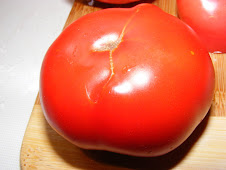
It's a tad early for starting seeds of anything yet unless your trying your hand at wintersowing, but I really start to get itchy fingers near the end of January. I don't start tomatoes until late March or Mid April, 6-8 weeks before my last frost date. So I decided perhaps if I write about it, that may scratch the itch for a little bit. And what else would come after choosing your tomatoes? Besides waiting for the seeds in the mail, that is.
I do have one little Galina happily growing in a pot under a lamp light, sitting right beside my desk on a shelf . I must check on her at least 5 times a day. Spring really can't come fast enough!
Starting your own tomatoes from seed is pretty straightforward. The three first key ingredients for germination are soil, water and heat. And once they've popped their noses out (germination), the fourth key is light. There are all kinds of fancy set-ups you can buy, and if you're creative, you can make some pretty slick outfits yourself. But whether you're growing a few plants for yourself, or a few hundred, you don't need to spend a lot of time or money. When I get my set up out of the shed, and actually working, I'll be sure to post some pictures. It's pretty simple and didn't cost me much.
What type of container you start your seeds in is entirely up to you and would also depend on how many you plan to start. I use the plastic cell packs that fit perfectly into the nursery trays, but small pots, even styrofoam cups are perfectly fine if you're not going to start that many. I start them off in the cells, and once they have a true set of leaves (or to be honest, probably longer), I pot them up into larger 4 inch pots. I start a few hundred plants, though, so for me this is the easiest way. And I am obsessive about checking them a few times a day, at least. If you are not the type of person who obsesses over plants, a larger starting container might be better, because they will not dry out as quickly.
So now for the soil. You can buy perfectly fine, very expensive seed starting mix, or you can make your own. Guess which one I do?
Of course I make my own. It's part of the fun! I use regular black earth (cheap at Canadian Tire, or other stores), vermiculite, perlite and peat moss. The ratio is approximately 1/2 earth, 1/6 each vermiculite, perlite, and peat moss. I kind of eyeball it, don't bother measuring it out. If I have good compost around, I'll add some of that too. I mix it all up in a big bucket, and then fill up the cell packs. Now water the mix in the cells, making sure it doesn't get too wet. If that happens, just let it dry out a few days before you plant the seeds. Now I'm ready to plant!
We'll get to that next time!



